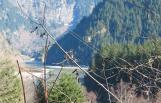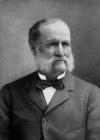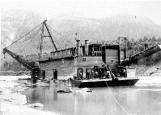1
Fraser River Gold Rush in YaleThe discovery of gold in the Fraser River sparked the Fraser River Gold Rush and Yale became an important destination. As such she saw a wide range of people from all over the world; former California 49ers, descendants of aristocrats, immigrants from Europe, Asia, Australia, South America; all entered the race for gold. Some built businesses or farms and opted to make B.C. their home, while others followed further rumours of gold and eventually left the province. Whether they stayed or went Yale at one time greeted them all.
3
James Moore and Edward HillDiscoverers of the Richest Gold Bar on the Mighty Fraser
These two partners discovered a fabulous placer gold bearing gravel bar and were forced to share it. Their reminiscences were recorded by David Higgins and the bar where they had made their brief fortune appropriately named 'Hill's Bar,' after co-discoverer Edward Hill. Yet, the history of B.C. was changed upon their discovery of the gold and their announcement of the fact brought a wave of humanity into B.C. from places throughout North America, Europe and Asia. Few can claim such a distinction as being the first to populate the colony.
Although gold had been discovered along the Thompson River, the Fraser had yet to have a major strike or discovery. The discovery of gold at 'Hill's Bar' confirmed that there was gold to be had in B.C. and with the California Gold Rush having peaked by 1858 people began coming to B.C. and traveling along the Fraser in droves.
On March 23, 1858 six former California miners stopped for lunch along the river bank fourteen miles from Hope. While eating Edward Hill noticed a glimmer in the moss at his feet, scooping up a handful he put it in his pan and washed it in the river. One of the miners with them that day, James Moore, was celebrating his 26th birthday and the reward must have seemed great. It did not take them long to recognize that the gold laden moss was not a fluke.
Recorded in B.C. history as the first big strike it set the precedent. In the words of James Moore, "when we located this mine we laid the foundation stone of mining in British Columbia, as this was practically the commencement of mining in the province." But, the discovery of the rich bar had a much greater impact on the colony than its gold bearing potential, for the miners at Hill's Bar that day "laid the foundation stone of British Columbia." 1
The bar was a mere 60 feet wide by five feet deep and yet it produced in excess of $2 million, the majority of which the original miners did not see. The six men did not immediately seek to spread the word of their good fortune; but traveling miners and local Natives soon realized they were onto something and mined alongside the discovers. However, it was when their provisions ran low that the word was leaked and the bar became a major destination.
James Moore was the last surviving member of the original six miners. He reawakened the story of the original settlers and at the time he retold the event he was considered amongst the oldest pioneer member in the province.2 Kamloops, prior to the First World War, had an old men's home stationed close to where the hospital is located now that over looked the burgeoning town. It was primarily established for old timers who struggled with the rapid advancement of British Columbia from miner's paradise to civilized settlement.
It was at this Kamloops home that James Moore showed up in 1914 at the age of 82. He was described as "broken and penniless,"3 upon his arrival at the home. But it was his arrival here and the recollection of his tale that enabled David Higgins, a reporter and writer, to record his words and forever preserve the first large wave of population and settlement into B.C. in 1858.
Written by Darla Dickenson
1- Paterson, T.W. Encyclopedia of Ghost Towns & Mining Camps of B.C. Vol I Langley; Stagecoach Publishing Co. Ltd. 1979. Pg 137
2- Paterson, T.W. Pg 137
3- Hutchison, Bruce. The Fraser.
5
Thomas JonesFellow California 49er
A 'Miner 49er' who made his way to Fraser gold before returning to San Francisco. His time in Yale was short, but in its briefness it tells a story of one of many prospectors who followed the lure of gold and mayhap came across a bit of romance and intrigue along the way!
In the words of a miner's great grandson John Siemer:
Thomas Jones was born June 25, 1827, in Frankby, Cheshire. His father's occupation was given as 'gentleman,' and his mother's maiden name was Martha Bloor. In late 1849 or early 1850, he left England and sailed 'round the Horn to San Francisco, to join the California Gold Rush. He engaged in placer mining in and around Calaveras County, where he met with some modest success.
In 1854, he married Ann Porter in San Francisco. She too had been born in England. As recalled from what my mother told me, Ann was on the same outbound ship from England (probably Liverpool) as Tom, but she continued from San Francisco across the Pacific with her mother and brother to join her father, an officer in the British Army, who had been posted to Sydney.
Apparently, on the voyage, she met and became betrothed to a friend sailing to California with Tom, and agreed to return to California when her fiancé had made his stake and had sent for her. Upon arrival in San Francisco, my great-grandfather, Thomas, met her and broke the news to her that her fiancé had recently died in the goldfields (probably cholera).
In the event, and because women were extremely scarce at the time, Tom lost no time proposing to her, and they were soon married. Altogether they had seven children, four sons and three daughters. Apparently, Tom went to B.C. to participate in the 1858 Fraser River gold rush, but he only remained for several months.
In the 1860 U.S. census of San Francisco, Thomas is listed as a carpenter, age 32, $600 real estate, $100 personal estate, born in England. The census also showed his wife, Ann, age 32, born in England, two sons and a daughter…The family lived at 934 California Street, which, in later years, becomes the prime real estate of Nob Hill. My mother also told me that the property was later sold to James Fair, namesake of the Fairmont Hotel subsequently built on the property, and that he paid for it with bogus mining stock! Thomas lived into the beginning of the 20th century, but I'm not sure of the date of his death. He and his wife were charter members of Grace Church in San Francisco (which became Grace Cathedral).1
Thomas Jones had been present at the very start of Fraser Gold Rush, following his fellow 49ers upriver to the banks of the Fraser. There is a record of Jones in Hicks record claim book: "I have this day recorded in favour of Messr. Jones, Smith, Jones, Hall and Smith the exclusive right; title and interest in and to the creek at Fort Yale, known as Yale Creek for sluicing, fluming and general mining purposes (170 inches of water allowed). Oct. 4th 1858."2
Very few miners opted to stay in Yale during the gold rush; they either followed the lure of gold further upriver or return home rather than continue to line the river banks in search of that elusive metal, gold.
Written by Darla Dickenson
1- Siemer, John. Personal Correspondence. Yale & District Historical Society Archives, October 22, 2003
2- Hicks Record Claims Book, 1858. UBC Special Collections
7
The Ladner BrothersWilliam Henry and Thomas Ellis
Packers, Prospectors, Farmers, Fathers of the City of Ladner
They were brothers who did not desire greatness or substantive wealth; rather, they appear to have lived life for all it had to offer, while learning from their mistakes. Distinctions that set them apart from the rest of humanity are few, and yet a place, Ladner's Landing was named in their honour.
The brothers were born in Cornwall, England to Edward Ladner and Sarah Ellis. Their father would immigrate to America in 1847 and Henry would follow shortly thereafter. Thomas opted to stay in England. In 1851 Henry returned to England and met up with his brother, and together they headed for Wisconsin where they followed the rumours of gold across the plains and into San Francisco.
In San Francisco they engaged in mining around the California area until 1858 when they heard the rumours of Fraser River gold. Departing for B.C. they arrived in Victoria by May of that year. Come June they had arrived in Hope where they engaged in mining and trading for some time. While residing in Hope, Henry received the distinction of being "appointed customs agent and government officer, having the honour of being the first constable appointed on the mainland of the province." 1
By 1861 they were successful businessmen, running a mule train into the interior. At this time freight rates were quite high, enabling them to make this venture a worthy one. Thomas only remained with the business for two more years, when he sold out and went to the Fraser River delta to settle, but Henry moved the business up into Big Bend country where he met with failure and returned to lower B.C. after a year.
Around the time that Thomas got out of the packing business he met and married Edna Booth in 1865. Edna passed away in 1882, leaving Thomas as the father of three. Thomas would have three additional children when he remarried Minnie E. Parr in 1884. Minnie and Thomas would also adopt a daughter, adding the total number of children under there care to seven.
In 1868, upon Henry's return to B.C., he settled in Delta, an area now known as Ladner's Landing. The Ladners were the first white settlers to that area. Henry pre-empted 160 acres of land in which he farmed and later raised enough money to purchase an additional 480 acres. Aside from farming Henry also distinguished himself in the community of Delta becoming reeve 2 of Delta almost continuously since 1880, justice of the peace since 1872 and has been police magistrate for the municipality of Delta for the past twenty years or more." 3 Thomas would also settle in Delta with his family and farm the land. In 1870 Henry lost his wife of fourteen years, Mary Booth, and was left with the responsibility of raising four kids. He remarried Mrs. McLellan in 1880.
Thomas while harvesting his land became interested in the profit margin that fish had the potential to generate. He established the first cannery on the lower Fraser and later acquired three additional fisheries. The company's name became 'Victoria Canning Co.' and Thomas was the general manager of the company. It was around the time that all canneries merged into the B.C. Packers Association that he was forced to retire from the business due to ill health. He was ill for 15 years before he was cured from the ailment through an operation. 4
The brothers started out with little but persevered and in the end made a close knit family and community with large goals amongst the small section of British Columbia that they opted to call home.
Written by Darla Dickenson, edited by Irene Bjerky
1 "William Henry Ladner." British Columbia: from the Earliest Times to the Present. Biographical, Vol IV. Vancouver: The S.J. Clarke Publishing Co., 1914. Pg 1118.
2 Steward or baliff
3 "William Henry Ladner," 1121
4"Thomas Ellis Ladner." British Columbia: from the Earliest Times to the Present. Biographical, Vol III. Vancouver: The S.J. Clarke Publishing Co., 1914. Pg 173-4
10
Gold RushThe rush for gold in B.C. lasted only a relatively short period of time and yet it was a major factor in the creation of British Columbia. Bringing colonists, settlers, prospectors and vagrants to the colony, it set the pace for future development in B.C.




